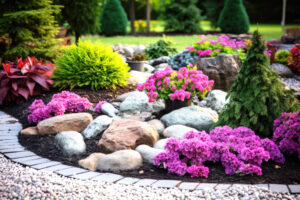The Importance of Mulch
Mulch can be a gardener’s best friend. It adds fabulous curb appeal as well as providing many benefits to the plants.
A covering of mulch makes any garden look better. Mulch is a form of ground covering and is used around trees and shrubs, around the house foundation, under hedges, in vegetable and cutting gardens or anywhere that you want to cover bare earth.
From a design standpoint, mulch adds continuity to landscape beds within the yard, helps to make newly planted gardens look fuller, and softens the line between garden and grass.
But mulch is far more than just a pretty face. It’s the key to low-maintenance gardening! Organic mulch deflects the sun and keeps moisture in the ground (a whopping 10 to 25% reduction in soil moisture loss from evaporation). This keeps the soil cooler in the summer. During the winter months, mulch acts like a big, warm blanket insulating the earth and plant roots. Organic mulch will naturally break down and decompose over time, which adds nutrients to the soil, promoting the growth of soil microorganisms and earthworms. This creates wonderful compost. Mulch helps to keep the soil well aerated by reducing soil compaction that results when raindrops hit the soil. It also reduces water runoff and soil erosion. And thankfully, mulch helps to keep down weeds and unwanted grass from growing in the landscape beds.
Types of Mulches
Organic Bark Mulches: Organic mulches are best because they are lovely in the garden as well as being very functional. Although they decompose quite rapidly and need to be replenished often (about once a year), it is this very decomposition that adds nutrients to the soil and improves the soil quality.
Bark mulch is made from a wide variety of forest trees – both hardwood and pine. It is natural and non-toxic. The bark is removed from logs by a debarker before they are sawed and processed into lumber products. The bark is then processed through an industrial hammer mill or shredder. Next, the material is screened into different types and sizes of bark mulch. The largest-size pieces are called chunks; the next size particles are referred to as nuggets; and the smallest pieces are called mini-chips or chips. The remaining fines are packaged and sold as a soil conditioner.
Wood chips (Unseasoned Mulch): Do not use freshly ground wood chip mulch around plants until it has had an opportunity to age (usually 8-12 months). Microorganisms use nutrients, particularly nitrogen, as part of the natural process of aging and decomposition. If the fresh wood chips are used as mulch around plants, the nitrogen and other essential nutrients needed for plant growth will be tied up by the microorganisms and unavailable to the plants, with poor effect on the plants up to and possibly including their death.
Unseasoned organic material, such as fresh wood chips or leaves, that has been stored in a large pile often goes through anaerobic (low oxygen, high moisture) decomposition and becomes very acidic — pH of about 3.0, much too acidic for plant growth. The mulch will have a smell of vinegar, ammonia, or sulfur. One byproduct of anaerobic decomposition, methane, is toxic to plants. Marginal leaf chlorosis, leaf scorch, defoliation, and/or plant death may occur.
A good use of fresh wood chips is as an economical cover for play areas and walking paths.
Stone Mulch: Stone mulch is an important design element for the modern garden. While stones do cover the soil and provide a bit of weed control, they do not improve the soil. Just be aware that rock mulch absorbs heat during the day and releases the heat at night which may mean that you will need to water more often.
Plastic Mulches: Plastic mulches usually come on a roll and are sold as “landscape fabric” or “plastic weed barrier.” While these products do help control weeds, we are not a big fan because they are made from plastics and are not organic, they do not provide nutritional benefits and have a bigger carbon footprint.
Porous landscape fabric allows rainwater to penetrate the soil. Initially, they work fairly well at keeping the weeds at bay, but the fabric breaks down too quickly for long-term control. A good use for landscape fabric is to put it down before installing a brick or stone patio or walk, under driveway stone, and under mulched paths and play areas.
Nonporous sheets of black plastic are not recommended for use in the garden. While they are very effective at keeping weeds from coming up, they do not allow water to penetrate to the plant roots.
Rubber mulch is not recommended for use around plants and should only be use for playgrounds, picnic areas, etc.
Too Much of a Good Thing?
While spreading organic mulch is one of the best benefits for plants, piling up too much mulch can end up killing them. Never use more than 3” of mulch around trees and shrubs. Thick layers of mulch will obstruct root development. If the mulch in the garden has turned into an impenetrable hard mat, there is too much mulch built up. You will need to either remove the mat layer or break it up with a garden fork. If mulch is piled up next to the trunk of a tree, it will soften and rot the tree bark creating easy access to disease and insects. If there is too much mulch in the garden, remove the old mulch before adding new. Old mulch can be added to the compost pile or worked into new garden beds.

